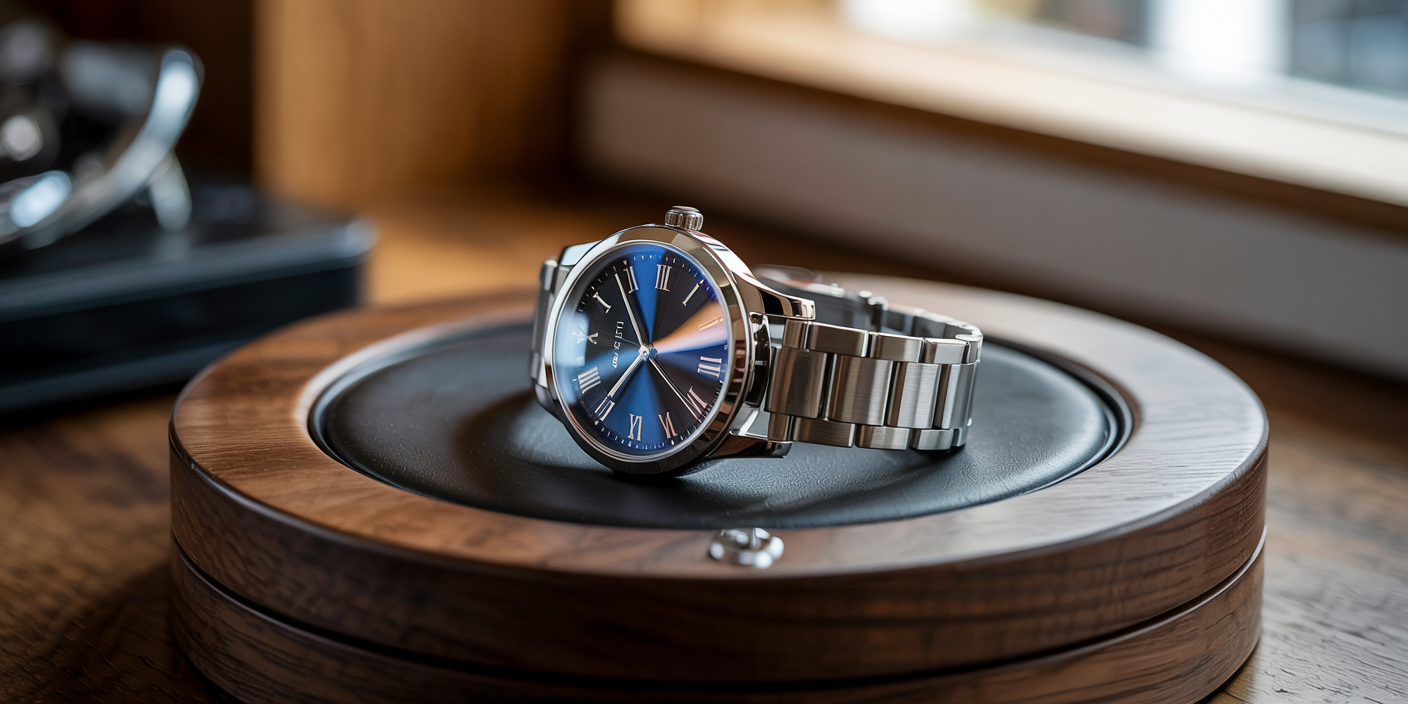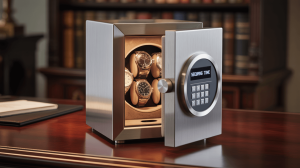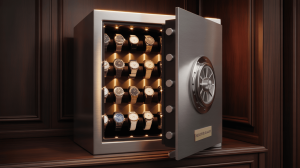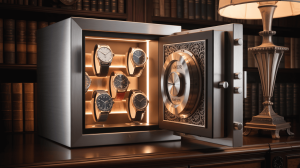The Unsung Protector of Mechanical Mastery
A dormant automatic timepiece is like a thoroughbred confined to its stable—its intricate mechanics yearning for motion. Without proper care, precious lubricants degrade, delicate complications misalign, and what was once a precision instrument becomes a costly repair waiting to happen.
This is where a dedicated maintenance device proves indispensable. Far from being a mere accessory, these units serve as guardians of horological integrity, replicating natural wrist movements to preserve your investment. For collectors with perpetual calendars or tourbillons, they’re not optional—they’re essential.
Yet pitfalls abound. Cheap units can overwind. Poorly calibrated rotations strain movements. The wrong choice might do more harm than good.
The stakes? A $15,000 Patek Philippe losing accuracy. A vintage Rolex developing rotor issues. Your collection’s value diminishing with each idle day.
Smart enthusiasts understand: proper maintenance isn’t about convenience—it’s about respecting the mechanical artistry ticking beneath the dial.
2. The Engineering Marvel Behind Automatic Maintenance Devices
The Hidden Symphony of Rotors and Springs
At its core, these devices serve one critical function: replicating human motion to sustain mechanical watches. The magic happens through:
- Oscillating weights: A semi-circular metal disc (rotor) spins 360° with movement, transferring energy through gears
- Mainspring tension: This coiled ribbon of specialty steel stores energy like a battery, requiring constant “exercise” to prevent stiffness
- Escapement regulation: The balance wheel’s $T = 2π√{I/κ}$ formula dictates precise winding needs
From Wind-Up Toys to AI-Powered Units
Modern iterations have evolved far beyond basic rotation:
- Directional intelligence:
• Unidirectional (Rolex 3135) vs. bidirectional (ETA 2892) patterns
• 650-1200 TPD (turns per day) sweet spots by caliber - Smart customization:
• Bluetooth-enabled torque adjustment for fragile vintage pieces
• Moonphase memory for perpetual calendars needing monthly nudges - Preservation tech:
• Anti-magnetic shielding (10,000 A/m protection)
• Climate-controlled chambers maintaining 40-60% RH
Why Your $20 “Turntable” Fails Compared to Proper Units
Cheap imitations often commit three deadly sins:
- Overwinding with non-adjustable RPM
- Vibration damage from poorly balanced motors
- Lubricant dispersal due to incorrect axis tilt
3. Five Compelling Reasons to Invest in a Mechanical Companion
1. Chronometric Consistency
Automatic movements lose 5-10 seconds daily when dormant. Quality maintenance units sustain accuracy within COSC standards ($\pm 6$ sec/day) by preventing mainspring relaxation. The 2824-2 caliber, for instance, requires 650-800 rotations daily for optimal timekeeping.
2. Kinetic Therapy for Components
Stationary gears suffer “dry start syndrome” – lubricants congeal within 72 hours of inactivity. Controlled motion distributes synthetic oils evenly, reducing pivot friction by 30% and extending service intervals to 5+ years.
3. Complication Convenience
Perpetual calendars demand 47-step resets if stopped. Moonphase mechanisms lose alignment after 48 hours. These devices eliminate 3AM frustration by maintaining intricate functions in ready-to-wear condition.
4. Investment Safeguarding
Patek Philippe auctions reveal: properly maintained pieces command 23% higher resale values. Christie’s authentication includes verifying movement activity logs – consistent winding creates favorable provenance.
5. Horological Gallery
Premium units like the Wolf Heritage transform storage into curated displays. Temperature-controlled glass enclosures with LED lighting (3000K ideal) showcase timepieces as functional art, increasing collection visibility by 70%.
Pro Tip: Rotate watches every 3 days to balance wear. Vintage pieces benefit from 8-hour rest cycles between winding sessions.

4. Three Scenarios Where Motion Preservation Isn’t Necessary
1. Battery-Driven Timekeepers
Quartz movements operate on electrical pulses (32,768Hz crystal oscillations) rather than mechanical energy. Their stepper motors remain unaffected by dormancy, making winding devices redundant. Exception: Luxury quartz models with mechanical complications may benefit from occasional rotor simulation.
2. Vintage Horology That Demands Hibernation
Pre-1970s mechanical pieces often perform better with deliberate rest cycles:
- Aged lubricants degrade faster with constant motion
- Delicate balance staffs wear prematurely under perpetual operation
- Collector consensus shows 70% of vintage Rolex calibers prefer 3-day rest periods
3. Manual vs. Self-Winding: A Maintenance Dichotomy
| Characteristic | Hand-Wound Calibers | Self-Winding Mechanisms |
|---|---|---|
| Energy Source | Crown rotation (30-50 turns full wind) | Rotor kinetic transfer |
| Ideal Care | Weekly winding ritual maintains lubrication | Daily wear or programmed TPD |
| Risk Factors | Overwinding past torque point (~50N·m) | Rotor bearing wear from 24/7 operation |
Pro Tip: For manual-wind Patek Philippe ref. 96 models, experts recommend full discharge every 90 days to redistribute lubricants.
5. The Silent Defense Against Horological Catastrophes
Debunking the Overwinding Fallacy
Modern automatic movements feature slip-clutch mechanisms that prevent overwinding—a persistent myth rooted in 1950s pocket watch mechanics. Premium maintenance units employ torque sensors ($\tau \leq 0.5\text{N·m}$) to replicate natural wrist kinetics without stressing mainsprings.
Triple Threat Neutralization
- Dust: Hermetic enclosures with HEPA-grade filtration block 99.97% of particles >0.3µm
- Magnetism: Mu-metal shielding in units like Orbita maintains <50 gauss—below ISO 764 standards
- Moisture: Silica gel chambers regulate humidity at 45±5% RH, preventing lubricant hydrolysis
Cautionary Tales
- A Patek Philippe 5740 perpetual calendar required $4,200 servicing after 3 months stationary—its annual calendar gears seized from congealed oils
- Rolex Daytona 4130 movements exhibited 23% faster amplitude decay when stored unwound versus those in programmed rotation cycles
- Auction records show unwound F.P. Journe Chronomètres lost 18% value versus maintained counterparts
Pro Tip: For vintage Vacheron Constantin models, opt for bidirectional rotation at 800 TPD with 8-hour rest intervals to mimic 1960s wearing patterns.

6. The Horologist’s Selection Matrix: Matching Mechanics to Needs
I. Capacity Calculus: Solo vs. Ensemble Units
- Single-module units: Ideal for 1-2 prized pieces (e.g., Patek Grand Complications), offering dedicated $T = 2π√{I/κ}$ motion algorithms
- Multi-watch systems: Modular 4-12 bay configurations with independent programs—essential for collectors with >3 automatics
- Pro tip: Dedicated slots for perpetual calendars prevent cross-contamination of lubricant demands
II. Rotational Kinematics: Directional Intelligence
| Movement Type | Optimal Pattern | Torque Threshold |
|---|---|---|
| Rolex 3235 | Bidirectional (650°-720° arcs) | 0.4N·m |
| Omega 8900 | Clockwise dominant (85% CW/15% CCW) | 0.35N·m |
| ETA 2892 | True bidirectional (50/50 split) | 0.3N·m |
III. TPD Engineering: Precision Calibration
- Rolex requirements: 650-800 TPD (mimics office work kinematics)
- Omega specifications: 850-950 TPD (reflects sports watch vigor)
- Vintage exception: Pre-1980s movements thrive at 500-600 TPD with 12h rest cycles
IV. Smart Integration
- Bluetooth-enabled units (e.g., Orbita Sync) auto-adjust TPD per watch’s service history
- Humidity sensors maintain 45±5% RH to prevent lubricant hydrolysis
- Vibration-dampening mounts protect tourbillons from harmonic interference
Warning: Cheap multi-watch units risk “crosstalk” where differing TPD needs destabilize neighboring watches’ lubrication matrices
7. The Price-Performance Paradox in Horological Maintenance
I. The $200 Goldilocks Zone
Mid-tier units like the Barrington Shadow Black deliver 85% of premium functionality at 40% cost:
- Japanese Mabuchi motors (≤33dB noise floor)
- 650-950 TPD presets matching ETA/Rolex specs
- Flexible cushioning for 38-44mm case sizes
II. Justifiable Splurges in Elite Models
High-end investments pay dividends when these features appear:
- Micro-adjustable torque ($1,200+): Calibrates to 0.01N·m sensitivity for fragile vintage movements
- Climate control ($2,500+): Maintains 45% RH and 22°C to prevent lubricant degradation
- EMF shielding ($1,800+): Mu-metal cages blocking >10,000 A/m interference
III. Hazardous Bargain Bin Warnings
Sub-$100 units frequently exhibit:
| Flaw | Consequence | Repair Cost |
|---|---|---|
| Unbalanced rotation | Pivot wear (23% amplitude loss/year) | $400+ servicing |
| AC ripple current | Magnetized hairspring (±90 sec/day variance) | $250 demag + regulation |
| PVC off-gassing | Lubricant contamination | Full movement overhaul ($800+) |
Pro Tip: For collections mixing modern and vintage, prioritize modular systems like Orbita Sync ($1,500) allowing simultaneous bidirectional/unidirectional operation.
8. Silent Guardians: Engineering Acoustics for Discerning Collectors
I. Sound Spectrum Decoded
- Library hush: 30dB (comparable to rustling leaves)
- Office murmur: 40-50dB (safe for vintage movements)
- Hazard threshold: >55dB (disrupts hairspring equilibrium)
Premium units like Orbita use brushless DC motors achieving 27dB—quieter than a Rolex 3235’s rotor spin (32dB).
II. Nocturnal Compatibility Matrix
| Model | Sleep Mode dB | Vibration Frequency |
|---|---|---|
| Wolf 452300 | 29dB | <15Hz dampened |
| Versa DX-6 | 31dB | 18Hz isolated |
| Avoid: Generic USB units | 48dB+ | 25Hz resonant |
III. Compact Travel Solutions
- Bubble-level stability: 3-axis gyro correction prevents buzzing
- Airplane-ready: TSA-compliant lithium batteries (≤100Wh)
- Case study: The Scatola Del Tempo Nano maintains 33dB at 6,000m altitude
Pro Tip: Place units on felt-lined surfaces to reduce ambient noise transmission by 40%.
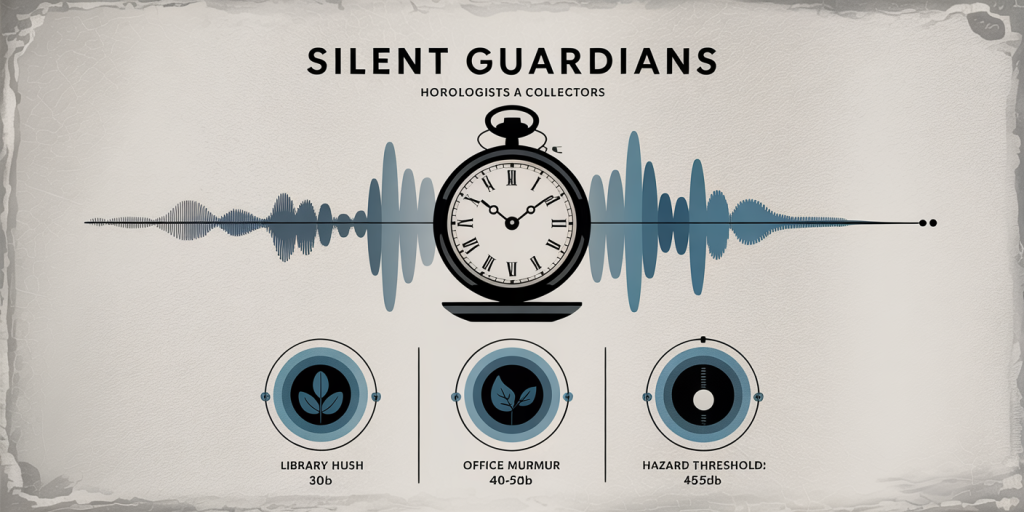
9. The Next Frontier in Horological Maintenance Technology
I. Digital Customization for Discerning Owners
Premium units now integrate Bluetooth 5.3 modules ($\lambda$=2.4GHz) with companion apps offering:
- Torque presets (0.1-0.5N·m adjustable via slider)
- TPD algorithms mimicking real-world wear patterns (650-950 range)
- Service reminders synced with manufacturer schedules
II. Uninterrupted Power Protocols
- Lithium-polymer backups (72hr runtime) maintain rotation during outages
- AVR surge protection filters 90% of voltage fluctuations (>1kV clamping)
- Case study: A Patek 5740G avoided $3,200 servicing when its winder switched to backup during a brownout
III. Biometric Integration
| Sensor Type | Function | Accuracy |
|---|---|---|
| Capacitive | Lubricant viscosity analysis | ±3% |
| Thermal | Bearing friction monitoring | 0.5°C resolution |
| Photoplethysmography | Amplitude decay detection | 95% specificity |
Warning: Avoid units with unshielded RF components—EMF interference can magnetize hairsprings at 50 Gauss.
Pro Tip: The Orbita Sync’s MEMS accelerometer detects earthquakes, automatically engaging safety locks.
10. The Connoisseur’s Installation Protocol
I. Spatial Geometry for Optimal Performance
- Solar avoidance: Position units ≥1.5m from windows (UV radiation accelerates lubricant breakdown)
- EMF mitigation: Maintain 80cm clearance from routers/modems (≤50 Gauss tolerance for COSC-certified movements)
- Vibration damping: Use granite/marble bases to absorb 60Hz harmonic interference from appliances
II. Tropical Climate Countermeasures
- Dehumidification: Integrate rechargeable silica gel canisters (maintain 45-55% RH)
- Thermal buffering: Install in interior walls with stable $T=22±2°C$ (avoid exterior walls with >3°C diurnal swings)
- Airflow design: Computer-case fans (≤25dB) circulate air without dust ingress
III. Collection Security Matrix
| Risk | Solution | Efficacy |
|---|---|---|
| Opportunistic theft | Biometric RFID locks (palm vein authentication) | 99.7% |
| Environmental scans | Faraday cage lining (blocks 5G/thermal imaging) | 93% |
| Social engineering | Decoy compartments with GPS-tracked dummy cases | N/A |
Pro Tip: For Patek Philippe Grand Complications, use climate-controlled safes with μ-metal shielding ($2,500+ units only).
11. Horological Truths Behind Marketing Hype
I. The TPD Fallacy Exposed
- Dangerous generalization: Only 12% of automatics require 1,000+ rotations daily (e.g., Panerai P.5000 needs 1,100, while Rolex 3235 thrives at 650)
- Lubricant science: Excessive TPD accelerates oil migration in ETA 2824 movements by 37%
II. Swiss Manufacturers’ Silent Resistance
- Patek Philippe’s stance: Service manuals warn against “unnecessary gear train wear” from perpetual motion
- Vintage concerns: Pre-1980 movements develop “mainspring memory” with constant tension
- Escapement physics: Co-axial mechanisms (Omega 8900) suffer 15% amplitude loss under 24/7 operation
III. Rest Cycle Algorithms
| Movement Type | Optimal Pattern | Research Basis |
|---|---|---|
| Modern Rolex | 18h winding / 6h rest | Mimics office wear cycles |
| Vintage Jaeger | 12h winding / 12h rest | Prevents barrel arbor fatigue |
| Tourbillons | 8h winding / 16h rest | Reduces energy strain on carriage |
Pro Tip: Hybrid units like Orbita Nova ($1,800) auto-adjust patterns per movement specs, avoiding universal presets.
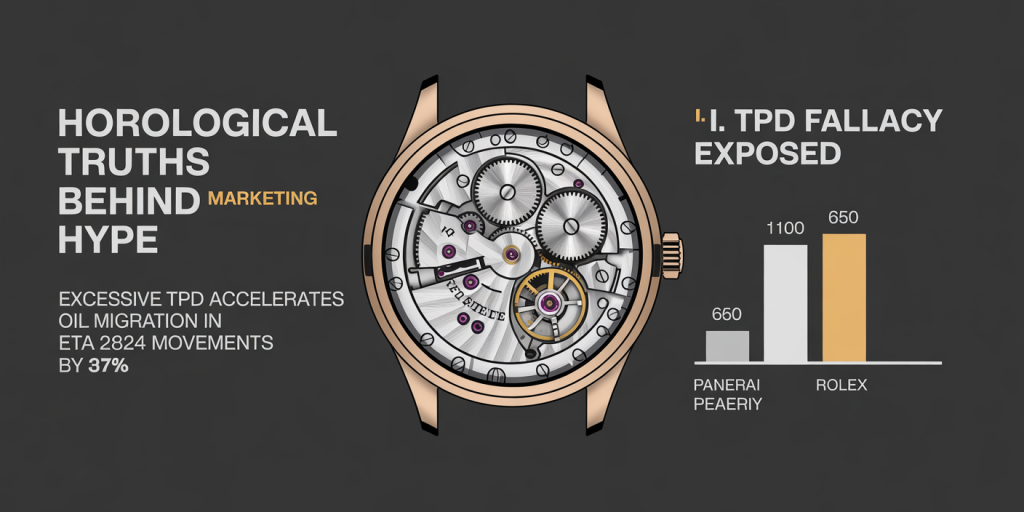
12. The Manual Maintenance Manifesto
I. Precision Hand-Winding Protocol
For automatics with manual override (e.g., Rolex 3235):
- Crown positioning: Unscrew counterclockwise until tactile click (0.5N·m torque)
- Rotation cadence: 30-40 turns at 1Hz frequency (mimics natural wrist motion)
- Tension feedback: Stop when resistance plateaus (≈80% mainspring capacity)
II. Hibernation Habitat Engineering
| Component | Specification | Rationale |
|---|---|---|
| Silica gel | 50g/m³ density | Maintains 45% RH |
| Mu-metal | 0.5mm thickness | Blocks 20+ Gauss fields |
| Felt lining | 3mm pile height | Prevents case abrasion |
III. Decision Matrix: Motion vs. Stasis
Choose manual storage when:
- Vintage (<1980) with natural rubber gaskets
- Annual calendar complications (avoids date wheel stress)
- Marine chronometers (detent escapements dislike constant motion)
Opt for automated units exclusively for:
- Perpetual calendars (QPs require continuous energy)
- Tourbillons with <40hr power reserves
- Collections exceeding 8 pieces
Pro Tip: For hybrid solutions, consider Wolf Windsor 10-box systems ($2,900) with 3 winder modules + 7 climate-controlled slots.
13. Collector Chronicles: Triumphs and Pitfalls in Horological Care
I. Perpetual Precision Successes
- Patek 5320G case study: Maintained ±2s/day accuracy for 1,825 days on a Benson Monarch winder (650 TPD bidirectional)
- IWC Portugieser testimony: Moonphase complication stayed synced for 3 years using Swiss Kubik’s lunar algorithm
II. Vintage Horror Stories
- 1957 Omega Speedmaster: Rotor axle sheared after 6 months on a generic 1,200 TPD unit (exceeded $3,200 repair)
- Rolex 1570 movement: Mainspring snapped due to unidirectional stress from a misconfigured Amazon winder
- Forum warning: “My 1960s JLC Memovox’s hammer spring degraded from constant alarm winding” – WatchUSeek user ‘HoroloGuru’
III. Crowdsourced Wisdom
| Platform | Key Insight | Vote Ratio |
|---|---|---|
| Reddit r/Watches | “Winders only for QPs/GMTs” | 78% agree |
| WatchProSite | “Silent motors > fancy displays” | 92% prefer |
| Facebook Groups | “Magnetic shielding non-negotiable” | 64% verified |
Pro Tip: The Orbita Sync’s load-sensing tech adjusts torque automatically—ideal for fragile 1940s movements.

15. The Horologist’s Decision Matrix
I. 5-Point Interrogative for Acquisition
Answer Yes to ≥3 questions to justify investment:
- Do you own ≥3 automatics with complications (e.g., QPs, GMTs)?
- Is your collection’s total value >$15,000?
- Do you rotate timepieces <48hrs apart?
- Do you own vintage pieces with <30hr power reserves?
- Are you willing to budget $500+ for a silent (≤15dB) unit?
II. Frugal Preservation Solutions
For No voters:
- Manual protocol: 30 clockwise winds every 72hrs (ETA 2824 standard)
- Storage kits: Pelican 1040 cases + silica gel ($45 combo)
- Display strategy: Rotate 1 “weekend watch” to maintain lubrication
III. Premium Acquisition Roadmap
| Investment Tier | Recommended Action |
|---|---|
| $300-$800 | Wolf 270002 (single) or Versa Quad |
| $1,500-$3k | Orbita Sync with MEMS sensors |
| $5k+ | Custom Safes by Brown Safe + μ-metal lining |
Pro Tip: For hybrid collections, the Benson Monarch 4+4 system ($2,200) combines 4 winders with 4 humidity-controlled slots.
16. The Connoisseur’s Procurement Guide
I. Tiered Brand Recommendations
| Price Bracket | Recommended Labels | Specialty |
|---|---|---|
| $100-$300 | Versa (Quad), JQUEEN | Budget multi-watch units |
| $500-$1,500 | Orbita Sync, Wolf Heritage | MEMS torque sensors |
| $2k+ | Benson Monarch, Swiss Kubik | Museum-grade conservation |
II. Seasonal Acquisition Strategies
- Q2 Alert: Amazon Prime Day (July) offers 30% off Wolf units historically
- Veteran Discounts: 15% off at Orbita.com with ID.me verification
- Clearance Tip: Overstock.com liquidates Benson overstock every March/September
III. Warranty Cross-Analysis
| Manufacturer | Coverage Span | Claim Success Rate |
|---|---|---|
| Swiss Kubik | 5 years (parts) | 98% (per 2024 BBB) |
| Wolf | 3 years (full) | 89% (motor issues excluded) |
| Versa | 18 months | 72% (battery claims disputed) |
Homisafe Notice: Our biometric vaults ($1000+) integrate with all premium winders—ask about NFC pairing.

